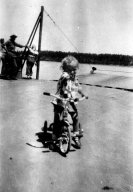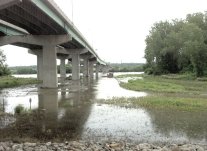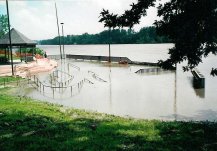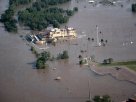The winter of 1951-52 brought heavy snowfall and was followed by warmer than usual spring temperatures, creating favorable conditions for a flood of great proportions
The Flood Control Act of 1944 approved numerous dams on the main stem Missouri River and its tributaries with a major focus on flood control
But construction of these projects was ongoing and by the flood of 52, none of the newly approved dams were complete
Melting of the snowpack began in late March on the Yellowstone River, while the ice was still thick on the main stem Missouri
The Yellowstone River crested on March 31st, creating a slow chain reaction in ice breakup along the Missouri River
A series of ice dams followed by flood pulses characterized the beginnings of this record flood
Major flooding occurred not only on the main stem Missouri River but on many of its tributaries of the Missouri River
At St. Joseph the Missouri cut off a sharp bend, shortening its channel and cutting off access to Rosecrans Memorial Airport
The Missouri River flood of 1952 was estimated to have caused damages of $179 million and displaced 87,000 people
Small ferries were used to carry autos across the Missouri river during periods of flooding
Photo #2 - April 13, 1952 St Joseph News Press photograph
Photo #3 - April 15, 1952 St Joseph News Press Headline
Photo #4 - Merry-Go-Round animals raised to ceiling for protection
Photo #5 - April 16, 1952 St Joseph News Press Headline
Photo #6 - Rosecrans AIrport with 5-6 foot flood waters
Photo #7 - April 25, 1952 SJ NP Photo - Bean Lake Flooded
Photo #8 - April 26, 1952 SJ NP Photo - French Bottoms citizens stay
Photo #9 - May 5, 1952 SJ NP Photo - ferry used since US 36 was unusable
|


 1
1
 2
2
 3
3
 4
4
 5
5
 6
6
 7
7
 8
8
 9
9
 1
1
 2
2
 3
3
 4
4


 1
1
 2
2
 3
3
 4
4
 5
5
 6
6
 7
7
 8
8
 1
1
 2
2
 1
1
 2
2
 3
3
 1
1
 2
2 1
1
 2
2
 3
3
 4
4
 5
5
 6
6
 7
7
 8
8
 9
9
 10
10
 11
11
 12
12
 13
13
 14
14
 15
15
 16
16
 17
17
 18
18
 19
19
 20
20
 21
21
 22
22
 23
23
 24
24
 25
25
 26
26
 1
1
 2
2
 1
1
 2
2
 3
3

